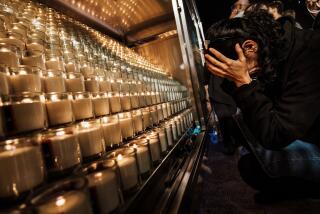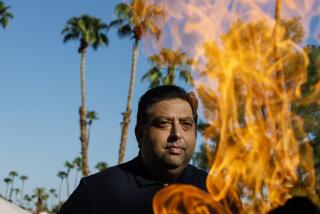Lesson of ‘Lord of the Rings’: Clarity in a Time of Darkness
- Share via
What do fire-breathing dragons and flame-spewing skyscrapers have in common?
The extraordinary commercial and popular success of “The Lord of the Rings: The Fellowship of the Ring” has as much to do with unconscious psychosocial forces as it does with its acting performances and entertainment value. Though it is a contemporary movie, it has tapped into a deep and ancient font of human yearning.
The dark events of both Sept. 11 and of the J.R.R. Tolkien fantasy film represent revelations--not of light, but of night. They present us--actually in the former case and imaginatively in the latter--with the opportunity to wrap our limited minds around the almost unfathomable, larger-than-life ideas of transcendent good and diabolical evil.
After the collapse of the World Trade Center, I walked through ground zero. It was during the Days of Awe. Before me was a scene of cinematic devastation: a wasteland of smashed buildings and shattered windows, monstrous pillars of twisted steel, smoke rising from the rubble.
As a law enforcement chaplain, I spoke with police officers, firefighters and rescue workers from dozens of different agencies and cities. I was moved by the acts of commitment and expressions of love that permeated that hellish place. And I was astounded by the vision of so many people finding their deepest, most beautiful selves in the heart of such an immense void.
Although most of life is about shadows and ambiguity, occasionally there are eruptions of absolutes, of clear examples of evil and good. As uncommon (and at times disturbing) as these eruptions can be, they offer us a kind of theological comfort food, a respite from the burdens of doubt and relativism that plague postmodern human beings.
Jung argued that there were no moral absolutes, that everything was an amoral and interwoven unity. A Jewish mystic once said that the person who does not see the sacred everywhere will not see it anywhere. Yet after the Sept. 11 attacks and events like them, such totalizing worldviews whitewash the discrete reality of evil too easily. It is a real, ontological power, a dragon that must be confronted and done battle with. Sometimes it is conveyed through fairy tales. Other times it slaps us in the face.
We need these mythic moments, these glimpses of moral clarity, to remind us that life has meaning and order, that the abyss of uncertainty is only an illusion waiting to be lifted. When it is, we discover our shared humanity, our community. The paradox is that it sometimes takes a revelation of night to disclose the sanctuaries that are potentially all around us. That is our tragedy and our gift.
The myth of the Ring and the myth of the Towers give us a similar message: Within every experience of darkness there are sparks of light in need of being kindled. Living without the language and imagery of myth is the real horror--a black, lonely hole that leads to nowhere.
*
Niles Elliot Goldstein is the founding rabbi of the New Shul in Greenwich Village and the author of, most recently, “God at the Edge: Searching for the Divine in Uncomfortable and Unexpected Places” (Bell Tower).
More to Read
Only good movies
Get the Indie Focus newsletter, Mark Olsen's weekly guide to the world of cinema.
You may occasionally receive promotional content from the Los Angeles Times.







